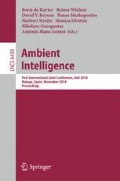Abstract
We present a dynamic time warping based activity recognition system for the analysis of low-level food preparation activities. Accelerometers embedded into kitchen utensils provide continuous sensor data streams while people are using them for cooking. The recognition framework analyzes frames of contiguous sensor readings in real-time with low latency. It thereby adapts to the idiosyncrasies of utensil use by automatically maintaining a template database. We demonstrate the effectiveness of the classification approach by a number of real-world practical experiments on a publically available dataset. The adaptive system shows superior performance compared to a static recognizer. Furthermore, we demonstrate the generalization capabilities of the system by gradually reducing the amount of training samples. The system achieves excellent classification results even if only a small number of training samples is available, which is especially relevant for real-world scenarios.
Access this chapter
Tax calculation will be finalised at checkout
Purchases are for personal use only
Preview
Unable to display preview. Download preview PDF.
References
Kranz, M., Schmidt, A., Rusu, B., Maldonado, A., Beetz, M., Hornler, B., Rigoll, G.: Sensing Technologies and the Player-Middleware for Context-Awareness in Kitchen Environments. In: Proc. 4th Int. Conf. on Networked Sensing Systems (2007)
Bonanni, L., Lee, C.H., Selker, T.: CounterIntelligence: Augmented Reality Kitchen. In: Proc. CHI 2005, pp. 2239–2245 (2005)
Bao, L., Intille, S.S.: Activity recognition from user-annotated acceleration data. In: Proc. Int. Conf. Pervasive Comp., pp. 1–17 (2004)
Ravi, N., Dandekar, N., Mysore, P., Littman, M.L.: Activity recognition from accelerometer data. In: Proc. Conf. Innovative Applications of Artificial Intelligence (IAAI), pp. 1541–1546 (2005)
Chang, K.-H., Liu, S.-Y., Chu, H.-H., Hsu, J., Chen, C., Lin, T.-Y., Huang, P.: Dietary–aware dining table: Observing dietary behaviors over tabletop surface. In: Proc. Int. Conf. Pervasive Comp., pp. 366–382 (2006)
Chi, P.-Y., Chen, J.-H., Chu, H.-H., Chen, B.-Y.: Enabling nutrition-aware cooking in a smart kitchen. In: Proc. CHI 2007 Extended Abstracts on Human Factors in Computing Systems, pp. 2333–2338 (2007)
Tran, Q.T., Calcaterra, G., Mynatt, E.D.: Cooks collage: Deja vu display for a home kitchen. In: Proc. HOIT 2005 Conf. on Home-Oriented Informatics and Telematics, pp. 15–32 (2005)
Olivier, P., Monk, A., Xu, G., Hoey, J.: Ambient Kitchen: Designing situated services using a high fidelity prototyping environment. In: Proc. Int. Conf. Pervasive Technologies Related to Assistive Environments (2009)
Pham, C., Olivier, P.: Slice&Dice: Recognizing Food Preparation Activities using Embedded Accelerometers. In: Proc. Europ. Conf. Ambient Intell., pp. 34–43 (2009)
Liu, J., Zhong, L., Wickramasuriya, J., Vasudevan, V.: uWave: Accelerometer-based personalized gesture recognition and its applications. In: Proc. Int. Conf. Pervasive Comp. and Comm., pp. 1–9 (2009)
Wu, J., Osuntogun, A., Choudhury, T., Philipose, M., Rehg, J.: A scalable approach to Activity Recognition based on Object Use. In: Proc. Int. Conf. Comp. Vision (2009)
Wang, L., Gu, T., Tao, X., Lu, J.: Sensor-Based Human Activity Recognition in a Multi-user Scenario. In: Proc. Europ. Conf. Ambient Intell., pp. 78–87 (2009)
Chow, C.K.: An Optimal Error and Reject Tradeoff. IEEE Trans on Information Theory 16(1), 41–46 (1970)
Xi, X., Keogh, E., Shelton, C., Wei, L.: Fast Time Series Classification Using Numerosity Reduction. In: Proc. Int. Conf. Machine Learning (2006)
Myers, C.S., Rabiner, L.R.: A comparative study of several dynamic time-warping algorithms for connected word recognition. The Bell System Technical Journal 60(7), 1389–1409 (1981)
Jayadevan, R., Kolhe, S.R., Patil, P.M.: Dynamic Time Warping Based Static Hand Printed Signature Verification. Journal of Pattern Recognition Research 4(1), 52–65 (2009)
Author information
Authors and Affiliations
Editor information
Editors and Affiliations
Rights and permissions
Copyright information
© 2010 Springer-Verlag Berlin Heidelberg
About this paper
Cite this paper
Pham, C., Plötz, T., Olivier, P. (2010). A Dynamic Time Warping Approach to Real-Time Activity Recognition for Food Preparation. In: de Ruyter, B., et al. Ambient Intelligence. AmI 2010. Lecture Notes in Computer Science, vol 6439. Springer, Berlin, Heidelberg. https://doi.org/10.1007/978-3-642-16917-5_3
Download citation
DOI: https://doi.org/10.1007/978-3-642-16917-5_3
Publisher Name: Springer, Berlin, Heidelberg
Print ISBN: 978-3-642-16916-8
Online ISBN: 978-3-642-16917-5
eBook Packages: Computer ScienceComputer Science (R0)

